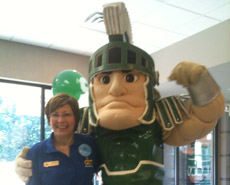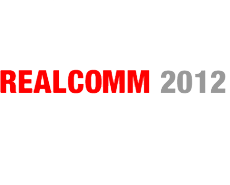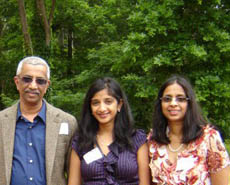Summer is here! Rental communities across the nation have speckled their event calendars with group fitness classes, barbecues, and game nights to entertain youth and adult residents alike. While such events may seem to serve only one purpose—fun!—they can be an important tool towards improving tenant retention. By hosting resident appreciation events on the property, owners and leasing agents can establish the sense of community that many tenants crave. Residents mingle, form friendships, and cut loose with a few light-hearted games and activities. Additionally, the property has the opportunity to showcase premiere amenities such as the pool and sundeck, media room, clubhouse, and fitness center. Resident appreciation events remind tenants of the community’s best features and reestablish the value of the property. Take a look at a few resident initiatives that cater to success: Apartment Communities Kick-Off Summer with a Splash Perhaps the most popular summer solstice celebration is the pool party and cookout combo. It’s the quintessential way to demonstrate resident appreciation in the warmer months. Residents are invited down to the community pool to cool off from the summer heat. Leasing office staff members serve tenants burgers, hot dogs, chips, and live music by a local DJ. To promote a more relaxed atmosphere, staff may decide on a themed event involving decorations and costumes. Stonegate Villas opted for a luau theme to their summer kick-off pool party. Student Housing Celebrates Independence Day Student communities near university campuses are hosting a variety of events for Independence Day, providing students with party options close to home. By bringing live entertainment, fireworks, and budget-friendly meals onto the campus, many student housing committees aim to decrease risks to student drivers while simultaneously forming a tighter sense of community among residents. As a Resident Life and community...
Digie Award for Orion
For real estate technology innovation
Yardi Orion™ for SharePoint®has earned a prestigious industry honor from Realcomm for Real Estate Technology Innovation. The Digital Innovation Award (Digie) recognizes Orion’s significant contribution to automation of real estate business intelligence, document management and portals. Released earlier this year, Orion is currently being implemented by numerous Yardi clients, who are thrilled with its ease of use, accessibility for various types of users, and individual customizations to fit a business’ specific needs. “Orion was conceived to solve an industry-wide problem. Companies were struggling to implement SharePoint in a way that it could be used effectively with a property management system,” said Rob Teel, senior vice president of commercial and investment management for Yardi. “The Orion framework solves the problem of security and integration between SharePoint and Voyager.” This is Yardi’s fourth Digie award. The company also earned recognition for its products in 2005, 2008 and 2009. For more on the award and Yardi Orion for SharePoint, read the full press release on...
Jo Marie Ziegler
DTN Management Company
You never know where life’s journey will take you. Jo Marie Ziegler didn’t start life as a Michigan resident or envision a career in the property management industry, but that’s where she ended up. In 1990, Jo Marie and her husband, Amos, moved to the Great Lake State so he could study at Michigan State University. 22 years later, Jo Marie has become a veteran property professional. Based in Lansing, DTN Management Company’s portfolio includes 6800 residential units, mainly in the Lansing and East Lansing area. This includes a significant number of properties serving Michigan State University students. A “can do attitude” is at the forefront of the DTN company values, and it’s a quality that Jo Marie exemplifies. She’s always ready to pitch in no matter what the need. For student housing providers, move-out and move-in is an “all hands on deck” time of year. Jo Marie described it as, “long hours and you’re constantly busy but it feels really good when you’re all done.” During move-out, her job transitions to managing the rehab and freshening up of numerous DTN properties. Armed with a spreadsheet and well-versed in how to communicate with contractors, she works to turn the units as quickly as possible. The rest of the year, Jo Marie’s job has a very different focus. A self-described “Yardi Guru” who helps with Yardi support and internal training, she has a natural knack for databases. Here’s how it started: “When we converted our property management software to Yardi, one of the owners asked if I would move from the Cedar Village hub to the corporate office so I could help get that conversion to Enterprise up and running. From there, with the help of our Spartan-Net IT department we progressed from 5.0 to...
Getting to the Future...
Corporate tenants, changing needs
Executives making long-term plans face an interesting juxtaposition: Significant changes lie ahead, but at the same time history is sure to repeat itself. How best to handle this? Move cautiously, but stay open minded and don’t be afraid to try new things. Never has the industry faced as many big changes simultaneously as those coming down the pike. The creation of the real estate investment trust vehicle, the advent of commercial mortgage-backed securities, the introduction of 1031 exchanges—certainly, all these and other big changes have had an impact on the market. But in the Digital Age, change is advancing ever more rapidly and is layered together with sustainability pursuits, new corporate office preferences and changing demographics. Technology by itself represents a big cog in the advancing real estate industry machine. Broadband and wireless communications capabilities and programs to track and analyze operations are only in their beginning stages—and represent only a portion of the possibilities that will impact workplace, housing and consumer venues. A new study published by CoreNet Global predicts that technology will soon be able to adjust the temperature, lighting, sound and other aspects of the workplace to the emotional state of its occupants. Elements as non-technological as the fire extinguisher may be monitored via an embedded microchip. And the U.S. General Services Administration is now mandating that its property managers receive information technology training. On the sustainability front, efforts are now focused on how to analyze all the data being collected on energy use, as well as ways to make small changes in operations that will have a big impact, according to Marc Heisterkamp, director of strategic assets for the U.S. Green Building Council. Municipalities are striving to determine methods of incentivizing greater compliance among property owners within their communities, while...
Wild About Wireless
A must for multifamily
As the multifamily housing industry booms amidst the slow recovery of the housing market, investors and developers are seeking prime real estate to seize the opportunities presented. To ensure the success of your upcoming project in a market flooded with competition, it is vital to consider even the smallest factors in tenant satisfaction. Today’s renter expects effortless, ample, and speedy wireless connectivity. For many properties, meeting this demand is an afterthought. Retrofitting a property to meet advancing technological standards proves to be infeasible in some cases and costly at best. Keeping wireless communication in mind when selecting the location and building materials for your property increases your chances of a completing a project with a competitive upper hand. Wireless Usage According to reports released by Mobithinking, there are over 1.2 billion mobile-broadband users worldwide. More than 25 percent of US subscribers are mobile-only users. PCs grow dusty in the corner of the home office as their owners perform work tasks, banking, and shopping via feature phones and smartphones. The pattern shows no signs of halting. Nearly half of mobile phones in the US are internet-enabled; that figure is expected to rise by 60 percent by 2015. It is clear that wireless is the future of communication. As users discover more tools and resources through their wireless devices, the demand for unlimited data plans will continue to rise. In addition to unlimited usage, wireless users are seeking faster access. For many devices, 3G capabilities come standard, with many enabled for 4G speeds. Resident Expectations As wireless usage grows in popularity, owners and managers risk losing business if they do not equip their properties with the best services. Multiple apartment search websites advise hunters to bring their cellphones along on the apartment search to check for coverage—and apartment hunters are listening. Cellular reception is perhaps seen as more of a necessity than on-site laundry facilities or a fitness center. Both of those services can be supplemented off-site but a strong connection to a tenant’s wireless service provider is irreplaceable. The internet has become a vital appendage for many renters, replacing, in many ways, traditional methods of human interaction. Writing a check and handing it to a staff member in the leasing office is basically unheard of. By 2015, m-payments or mobile payments are expected to be worth $1 trillion. Tenants seek online services such as bill pay, community message boards, and even their residence’s presence on social media platforms such as Twitter and Facebook. Home automation is gaining popularity as well, allowing renters to control aspects of their rentals remotely. The property must be equipped to provide those basic services to survive in today’s competitive multifamily housing market. Building Conundrums Location is key to providing tenants with a strong connection to prominent wireless providers and consistent coverage throughout the property. The importance of location does not come as a surprise to any builder yet few have taken the time to consider it from a technical standpoint. Sites that can offer tenants the best coverage by multiple carriers are better prepared for success than sites with limited coverage. This includes everything from cell phone and internet to cable, satellite, and security providers. Major urban districts furnish locations with the best multi-provider coverage. Unfortunately, these high-coverage areas may not be conducive to new constructions. In an age that favors building conversions, this may be a developer’s best option. The development team must then examine the building materials used in the construction of the preexisting structure to determine if those materials will interfere with wireless services. While converted buildings have demonstrated success in the rental market, retro-fitting a site for superb wireless performance may be inefficient and costly. New constructions are not without their own challenges. Sustainable building, for example, has its benefits but many ecologically friendly materials have adverse effects on wireless connectivity. Certain types of energy efficient insulation and green roofing can...
SEE International
Restoring vision worldwide
Eyesight: it enables us to take in the world around us, navigate our daily lives with ease, and appreciate beauty. If your eyesight was taken from you tomorrow, would you be able to continue to function in your daily life? One of many non-profits that receive corporate philanthropic support from Yardi Systems, Inc. is Surgical Eye Expeditions International, (SEE) a Santa Barbara, Calif. based global organization that sends doctors to assist those in need of eye surgeries around the world. Since 1974, SEE’s eye surgeons have examined more than 3.2 million patients and performed over 400,000 sight-restoring operations. SEE International’s volunteer eye surgeons donate their time and pay for all their own travel expenses. During each clinic (approximately five days long), sight is typically restored to 50 to 200 people. “SEE has been thrilled with Yardi’s responsiveness and willingness to support our mission of restoring vision around the world,” said Rachel Johnston, Grants Coordinator for SEE International. To date, the company’s donations have aided more than 300 vision restoration patients in India. The patients who benefit from SEE’s clinics are adults and children. Nearly all live in developing countries, and 48% are blind because of cataracts. Thanks to SEE, they are often able to achieve vision restoration – 80% of the cases are avoidable or treatable. SEE also works in its home community of Santa Barbara. The Santa Barbara Vision Care Program was created to fill the need in Santa Barbara County for those who cannot afford vision care and have no medical insurance. Over 51,000 patients have received free eye screening in this local program. Yardi Systems encourages you to make a donation to the non-profit of your choice this year....
Yardi Volunteers
North Texas Food Bank
We’ve frequently shared news with you here about Yardi Systems’ numerous donations to various philanthropic causes that help people across the U.S. and beyond. Today we’re focused on an effort of people power by Yardi employees in our Dallas, Texas office. Led by Michael Sheaffer, 20 people from the Customer Service Desk gave their own time on a recent Saturday to volunteer at the North Texas Food Bank. This organization supports hungry families and individuals throughout the North Texas area with healthy and nutritious meals. “Our team discussed options and we all agreed that we are very fortunate to have jobs and to work for Yardi. We determined that we needed to do some sort of outreach where we could directly impact those that were not as fortunate and give back to our local community. The North Texas Food Bank is a very reputable organization that relies on volunteers to ensure they maximize their food and financial donations to help reduce hunger in our local area,” Sheaffer said. During their volunteer day, the Yardi team was packaging nonperishable food items for delivery to seniors. A regular box delivered to these seniors in need helps them supplement limited foodstuffs that they’re able to afford. In just three hours, 16,000 meals had been packaged for donation. “We chose the food bank based on individuals in the group volunteering individually in the past and the impact they were able to make. Our thought was that we would give up a Saturday once a quarter to give back to our community and make sure that we see that there is more to our lives than just the normal 8-5 that we work for Yardi,” said Sheaffer. “Surprisingly, we had almost perfect attendance from our group and we even...
Mobility & CRM
Insight from Realcomm 2012
With a commitment to deliver the most relevant, up-to-date insight and technology available for the commercial real estate industry, Realcomm attendees typically seize the chance to investigate the latest tools. With over 100 vendors, searching for a product with the breadth and footprint to fit your business was a top priority for many attendees at this conference, held June 13-14 in Las Vegas. The vendor expo was alive with buzz, and hot topics included smart building technology, CRM, and mobility. Historically, a major hurdle for commercial real estate has been the brokers’ reluctance to share their contacts. After all, a positive (and often long-term) client/broker relationship has consistently proven to be a driving force behind closing deals. For brokerage firms, this has been a constant obstruction to the industry’s adoption of technology: figuring out how to secure the information available inside a CRM to a point where brokers feel their relationships can remain intact while still allowing the firm to access the decision making information they need. Fortunately, improved technology has led to convergence: being able to see the pipeline, discover possible closes, and most importantly increase revenue by lowering vacancy rates all the while maintaining a secure database of clientele that’s available on the go. Mobility is transitioning from a luxury to a necessity and as a result was an equally hot topic. In part due to increased security concerns brought about by the recent mobility and BYOD (bring your own device) trends have left commercial real estate IT executives in perpetual problem solving mode. There’s a lot to think about when it comes to incorporating the consumer driven tech fads we see today; security being at the forefront. At our recent user conference, Yardi Voyager clients learned about the syncing and wiping...
No Lead Left Untracked...
Brian Maguire, Industry Principal
With a wealth of experience in the apartment advertising industry, Lead Tracking Solutions wanted clients to be able to know exactly which of their ad campaigns had generated leads, prospects and phone calls – without a margin of human error. Paper guest cards, hand-entered into a database, were just too antiquated and unreliable. The result is what’s now known as the Yardi PopCard, an automated guest card that automatically populates when a prospect contacts a property. Yardi PopCard is fully integrated with Yardi Voyager, meaning leads and follow-up opportunities can’t be lost and automatically appear in Voyager once received. Yardi acquired Costa Mesa, Calif. based Lead Tracking Solutions in April 2012. In addition to having a very cool name, the PopCard gives multifamily firms more control over the lead management process, and LTS’ support staff helps clients maximize their advertising budget in an effective way. “With lead management we can go back to clients with reports, and whether per ad campaign or employee performance or region or we’re going to give you all the tools and management capabilities to say ‘cancel, upsize, downsize,’ your efforts,” co-founder Brian Maguire explained. LTS also offers the tools to track follow-ups by leasing agents, so you can view how many inquiries they are receiving from prospects and how quickly they’ve responded to prospects via email. “Many of our clients say: ‘I wish I had this information before. It’s simple if you think about it, but nobody’s ever done it before. Now I know exactly what’s going on at my sites without having to be there,’” Maguire said. LTS’ audit and success team helps clients interpret the results and make good business decisions based on the information collected. Major multifamily firms using Yardi PopCard include Riverstone Residential Group, Pinnacle,...
Student Housing
Low budgets, high expectations
Student housing has grown out of its niche sector. More universities are turning to third party firms to meet the needs of increasing enrollment, and multifamily firms have been responsive.The demand for student housing is high – a recent National Multi Housing Council white paper revealed that a 38.7 percent increase in university enrollment over the past decade is creating a shortage of on-campus housing nationwide, and students who can’t find dorm accommodations naturally spill off campus to other options. “States aren’t keeping up with building housing for the students that they’ve got. That presents a huge opportunity for private developers,” Jim Arbury, vice president of student housing for the NMHC’s National Student Housing Council, said in a recent interview with National Real Estate Investor. Promising yields draw investors in droves, but also bring unique challenges for housing providers. Those that experience the most success understand what separates student housing from other multifamily housing projects. Today’s young renter requires a balance between private and public space, with living arrangements that promote social interaction but also offer quiet spaces for study and privacy. There is also an emphasis on technology and security. Meeting these needs forces a different approach to housing designs, amenities, and staffing than the methods use in traditional apartment communities. What Students Want A report by J Turner Research and the National Apartment Association reveals that suites—with private bathrooms attached to each bedroom—are considered necessities by 40 percent of student renters and 62 percent of parents. Spacious bedrooms with study nooks or built-in desks, ample storage, and in-unit laundry appliances also topped the list of desirable features in housing. Award-winning developments offer multiple pools, 24-hour fitness centers, gaming rooms, theaters, coin-free payment options for laundry services, and an active staff that hosts multiple community events, group classes and excursions, and other resources for social interaction amongst residents. Security features have not been overlooked by students or parents. A growing number of student projects are equipped with heightened security measures such as near field communication (NFC) and radio frequency identification (RFID) locks. Such features allow students to use mobile devices to control access to their bedroom doors via an electronic receiver. This minimizes the need for keys and can allow students to lock doors quickly and remotely. The conveniences of modern technology cannot be overlooked with today’s student renter. Online leasing services are growing in popularity and availability across university communities, since rental decisions are often made remotely before arriving in the college community. Students likewise enjoy the ease of submitting payments online (particularly in cases where the parents are making payments on the student’s behalf). Utilities, garbage, and other such fees should be included in the monthly rental statement, with just one payment necessary, to simplify monthly transactions. It is also vital for student housing to include the electronic infrastructure necessary to support the best available internet speeds, data demands, and coverage for the most popular wireless carriers in the area. A Presta Electronics poll found that within 5 years, 22 million students will take classes online. The poll also revealed that 73 percent of students say they “cannot study” without technology. And 38 percent claim that they cannot “go ten minutes” without checking email or using a smartphone, tablet, or laptop. Look Before You Leap, Then Look Again As architects, builders, and developers scramble to establish themselves on firm ground, many have turned to student housing. According to Jamie Wilhelm, executive vice president of public-private transactions for American Campus Communities Inc, recent projects are cited to yield returns between 7 and 8 percent. As appealing as those figures may seem, student housing is not a sector for novices. Even seasoned firms encounter a myriad of challenges. The cost of building to students’ demands doesn’t always mesh with efficiency standards or price points for universities, prompting creative resolutions. Mixed-used facilities are increasingly common in student housing. Services—such...
A Look Into iOS 6
Apple operating updates for fall
Your favorite Apple devices – the iPhone 3GS, iPhone 4, iPhone 4S, iPad 2, third-generation iPad, and the fourth-generation iPod touch – get a makeover with the new iOS 6 upgrade that will be rolled out this fall. The announcement, made during the keynote speech to the Apple Worldwide Developers Conference, went into some detail about what we can expect from the newest iteration of the popular operating system: 3D maps. This is a big leap forward for Apple, and a shot across Google’s bow in the increasingly bitter rivalry between the two companies. Designed completely in-house, the new iOS 6 maps function utilizes a vector-based engine to render locations – this means ultra-crisp graphics, fast and smooth panning & zooming, and ample incentive to explore. Functionality includes turn-by-turn navigation, real-time traffic information and alternative routing, fly-over mode with photo-realistic 3D views, full Siri compatibility, and a host of local search options. More Siri. You’ve probably already seen the cute commercial featuring John Malkovich chatting with Siri. iOS 6 expands Siri’s range of functions. Instantly receive sports scores, stats, and schedules. Find movie locations, showtimes, and much more. Browse restaurants with a host of sorting options and make reservations effortlessly. More languages supported than ever before. Full social networking without having to type a word. Updated phone & email. New calling features allow you to respond to declined calls with a text message or a reminder, or turn on a “Do Not Disturb” sign that only lets through your most important callers. Email interface is streamlined for ease of reading & writing. New Passbook app. Keep all of your boarding passes, retail coupons, movie tickets, loyalty cards, and more all in one place. At-a-glance organization of balances, important dates, and updates. Leave your wallet...
Dave Woodward
CompassRock Real Estate
From his high-rise office in downtown Denver, Dave Woodward has a great view of the snow-capped Rocky Mountains just beyond the Mile High City. He’s also taking the long view with his new company, CompassRock Real Estate. Formerly the CEO of the Laramar Group for 12 years and prior to that a senior vice president at Archstone, UC Berkeley grad Woodward has spent his career as a property management executive. He’s now using those years of experience in a new firm that focuses on properties from special servicers, lenders and other institutional owners. “One of the things that’s really exciting for me is that CompassRock isn’t just a multifamily company, we are providing property management and other services to all real estate product types.” Dave told us. “CW Capital is my initial financial partner, with six other clients also signed up. They will help by contributing some of the management assignments in their portfolio.” The initial portfolio will be comprised of distressed assets, mostly taken back through foreclosures. In some cases, CompassRock will also be stepping in as court-appointed receiver while the properties work their way through the foreclosure process. Generally a two to four year window to maximize values, clean up the assets and position the properties for sale is common. “Our plan is to manage a lot of these properties and then retain management when possible upon sale. In addition, we’ll be managing for longer-term owners as well.” Dave explained. His business model at CompassRock will maximize efficiency with two key best practices he’s identified over the years for cutting down costs: -A shared services system for back office human resources, accounting, information technology and risk management will streamline those functions across all management categories. -Outsourcing some lower-level services, such as monthly...
200 Years of Homes
NYC Architecture
Our friends at Property Shark have put together a great slideshow that displays homes built over the last 200 years in New York City’s Greenwich Village and Brooklyn Heights. Unless you happen to live in a particularly old and historic part of the U.S., it might be hard to find a home more than 100 years old in your neighborhood, but in this part of New York City they are very plentiful. You’ll probably notice a lot of similarities in the architectural styles displayed in these slides – rectangular shapes, flat fronts, short-walk ups, uniform windows and always the inference that inside the front door, you’ll probably be heading up a flight of stairs. Visit Property Shark for more insight into the world of New York City real estate, including in-depth market reports, blog posts, foreclosure and sale listings, and individual property...
Stamping out Smoking
Towbes Group goes smoke free
Last week we told you about the growing national trend of apartment communities that are prohibiting smoking altogether, rather than limiting smokers to certain apartments, and have been backed up by legislation in some states that OKs the restrictions. This month, Yardi client The Towbes Group of Santa Barbara, which has multifamily and commercial properties on California’s Central Coast, announced that it is going smoke free in all of its apartments. New renters moving in will be prohibited from smoking in their units, and any existing tenants are required to cease smoking on Towbes properties by the end of the year. The incentive for the change? Financial. Towbes vice president Jim Carrillo told the Los Angeles Times that the company spends considerably more rehabbing apartments for the next tenant if the previous occupant has been smoking in the unit. Residents with concerns about secondhand smoke and residual smoke that saturates walls and carpets will certainly welcome the change. With 13 apartment communities and nearly 2100 units, Towbes is the first major California property manager to institute a total on-site smoking ban. What do you think about the new legislation that offers landlords the chance to ban smoking? Would you prefer to rent in a smoke-free community? Or do you think the new legislation is too restrictive?...
Talking to the Rentennials...
Eschewing home buying
Oh, those hard-to-pin-down, picky renters and their hearts’ desires. Every year, major research and development dollars are spent by trade associations and independent companies to try to figure out what will make renters choose one property over others, pay more rent for certain amenities, and stay on as long term residents. What’s being most closely scrutinized is the predilections of the “Millennial” apartment renters – the kids of Baby Boomers, ranging in age from recent high school grads to those in their early 30s – who are expected to favor renting over home ownership. As a result, some have changed their generational label to the “Rentennials.” Is it accurate? A recent National Association of Home Builders (NAHB) panel that looked at these trends expects these renters to want urban-proximate multifamily housing, with easy access to efficient public transportation as well as walkable neighborhoods, for ease of commuting and lifestyle convenience. NAHB is betting that the Rentennial trend will be a source of income for their industry in the years to come. We decided to take this research one step further and ask a group of Millennials/Rentennials how they feel about renting, home ownership, and what they want in their “ideal” apartment building. Here’s what they said. The perfect apartment? According to the NAHB, it’s the location of a property that will be the pivotal factor in attracting most renters, who dislike traveling long distances to their jobs. This insight is accurate, according to the young renters we heard from. And it’s also true that renters today want convenient public transportation access and walkable neighborhoods. “It’s all about the lifestyle for today’s renters. They want the urban experience of less commute time and immediate access to various activities,” said Jeff Kayce, vice president at Bozzuto...
The App Economy
Room for growth in real estate
Ever wondered how apps – those fun little programs on your iPhone, iPad or Android that do cool things like provide your bank balance, tell you when your mortgage is due or give you the latest local weather forecast – have influenced our tech economy? Studies show that application development is quantifiable as its own economy. Last year, it was determined by analyst Michael Mandel (published by TechNet), that the app market has added 466,000 jobs to the US economy since 2007. That number has surely increased by tens of thousands in the last 12 months, as Mandel called app development a “job leader” in America’s continuing post-recession recovery. While apps are only a small fraction of the technology industry, they represent one of the fastest growing new fields. For iPhone and iPads alone, there are over 500,000 apps serving over 845 million users, numbers that are growing daily. Tack on the growing number of applications for Android and other devices and the app explosion is exponential. Zynga has been one poster child for app-driven success since the industry’s nascent stages. The company, which currently employs nearly 3,000 workers, has recently purchased the space needed to add thousands to the workforce in coming years. Fellow San Francisco app company Airbnb is doing the same. These two companies, along with Twitter, and other smaller tech/app creators expanding in the Bay Area have triggered a regional real estate boom that has led to rising rents, low apartment vacancy rates and inflated housing prices. It’s just one regional example of the power the app economy can wield. Worldwide, enterprising app developers seeking investor funding are pressing forward with the confidence that the industry will only continue to grow, particularly beyond smartphones and tablets. According to Business Insider, annual tablet sales will pass personal computers in three years or less. They quantify apps at a $10 billion market, growing at 100 percent per year. The transition to using apps for anything and everything – this week I used an app to budget for the coming month, pay my smartphone bill, pick out a movie, and find out when the tide would be out at the beach near my home – is a consumer shift that will continue to evolve. For the real estate industry, apps are being developed to meet immediate needs like marketing and rent remittance, but that reach is likely to expand quickly as tablet use becomes even more pervasive. The youngest technology users – teens – will have a much different experience than you and I are used to, and it will be app driven. Current products focus mainly on finding real estate to purchase, looking at purchase price or appraisal value data, and other services for the home buyer. Fast forward five years (or maybe just two) and imagine that you are looking for an apartment. Rather than heading for your bulky desktop and waiting several minutes for the Internet to load up, you’ll access your smartphone or tablet and have instant fast wireless connectivity. Using a search app, you’ll quickly be able to bring up any available apartments in the geographic area you’ve selected. With the push of a finger you can express an interest in that available apartment unit or request an appointment for a showing. The leasing agent can text you back with an available viewing time, or if you’re searching from out of the area, perhaps you’re ready to start your lease application. One more finger tap and you’ll be on your way. For residents, the convenience of app-based rent pay, lease renewal and work order submission will be a no-brainer. Designed to simplify our lives, apps should indeed save time and maximize our efficiency. Apps touching on some of these renting-related tasks already exist, but are yet to be seamless experiences. The app economy will change that. And for property professionals, apps will have different...
Homeward Pikes Peak
Helping homeless find stability
Dr. Bob Holmes, executive director of the Colorado Springs-based Homeward Pikes Peak, isn’t trained as a social worker. He has an MBA and a background in education. Holmes is also a Vietnam veteran who fervently believes that job training, support and residential stability is the way to get homeless Americans back on their feet. His innovative model for doing so, Homeward Pikes Peak’s Homeless Outreach, is one of three programs Holmes oversees that support the homeless population of Colorado Springs. The Homeless Outreach effort focuses mainly on women and kids, and has served 1,868 homeless in the last 27 months. “Our total helped toward self-sufficiency is 1,409 or 75% of those entering our program,” Holmes said. “The program budget is $217,200 per year and I raise this through the generosity of foundations, such as Yardi; faith-based organizations and individuals.” Once jobs are found, the families are allowed to stay at the Aztec long enough to build up their savings for a deposit and first month’s rent on an apartment. Average residency time at the Aztec is two to three months.With room for up the 80 residents at the Aztec Motel, a struggling local property that agreed to rent exclusively to the program, Holmes and his team of 2 full time, one part time case workers assist their residents not just with housing but identifying job skills, seeking out interviews and support. Homeward Pikes Peak adults must make multiple job contacts daily, and they also participate in cooperative child care and eight hours of community service per week. Children – there are 42 at the Aztec this week – must be in school. The success stories come from all sides of the spectrum. One resident, a jobless tech worker, landed a position at Hewlett Packard....
America’s Changing Face...
Demographic trends
America today is a veritable melting pot of demographic trends. The first Baby Boomers have arrived at senior citizen status. The population’s balance is shifting, with the historical white majority on its way to becoming the minority, while certain minorities are on their way to becoming the majority through a combination of organic growth and immigration. A huge pool of new graduates is pouring into the market. And urban centers are exploding at the expense of the suburbs. While this flood of significant shifts is impacting virtually every property type, perhaps none is more influenced than the retail sector. Successful retailing requires layering preferences, price points and geographic placement—and tracking how these are changing to better address them with the right offerings in the right locations. Complicating this targeted planning is the growing influence of technology, in particular the competition from online retailing—so-called etailing. Retailers and retail real estate owners alike are striving to sort through all this to make the best decisions, and the array of data available to them continues to grow. Arguably, they are getting ever better at following it, although not perfectly—after all, while a variety of new retail concepts have come out, over-retailing continues to impede the industry, only to result in shutdowns and bankruptcies during lean years, as has occurred in especially large numbers during the most recent recession. There is still room, however, to pursue new opportunities, and some interesting ones are emerging. Take, for instance, the potential in the generation now crossing the retirement threshold. While retailers are generally focused on younger shoppers, drawn by their huge numbers and propensity to develop brand loyalty, older Baby Boomers actually constitute a better option, according to Nielsen Co. data. Per capita, their average expenditures are noticeably higher—at $25,952...
Shridhar Sheshadri
Yardi
With an international background in accounting and property management, it makes perfect sense that Shridhar Sheshadri landed at Yardi as a Senior Consultant in the Professional Services Group, based in Yardi’s Toronto, Canada office. His career has spanned four continents, taking Shridhar from his home country of India to the United Kingdom, Nigeria, Australia and New Zealand, Dubai, and now to Toronto, where he and his family have lived for nearly seven years. The opportunity to work for Yardi came along after his Canadian immigration paperwork had been approved. Shridhar told us he was struggling with the decision to leave Dubai, since he had a good job there as a controller for a large property management company. But after being referred for an interview by his brother-in-law, everything fell into place. “It was lightning speed. I think it was providence,” Shridhar said. After spending much of his life moving and also traveling for professional reasons, he hopes that Yardi Systems will be the company he retires from. His widely varied experiences, from his career start as an accountant in India to his oversight of factories in Nigeria and property management of one of the world’s largest residential towers in the Middle East, have given Shridhar a unique perspective that comes in handy when he visits Yardi clients. He travels to assist clients in the U.S. and Canada with their professional implementation processes. “This position has allowed me to mix my past experiences, my background of being a Chartered Accountant, all of my professional experience – and sit across from a Board of Directors and discuss their business rules, how their entire organization works, and try to translate how Yardi programs can best help them,” Shridhar explained. The move to North America has been advantageous...
Shutting Out Smokers
Some states ban butts
As the multifamily industry moves forward, many firms are choosing to create sustainable housing that also fosters a healthy lifestyle for its residents. Firms select sites with easy access to public transit and bike lanes. Communities receive fitness centers, walking trails, and programming like exercise and yoga classes. Many of these health-related amenities welcome residents to participate at will. A tenant’s decision to work towards better health has not, in large part, affected anyone other than the tenant. A new wave of health-conscious legislation may force tenants to take personal responsibility for the health of their neighbors. Residents say that they want to live in smoke-free environments, but they’re not willing to pay extra for it. Industry leaders and health officials have teamed up to evaluate the effects of secondhand smoke in multifamily housing and the hospitality field. As research mounts in favor of smoke-free residences, managers and owners are forced to make the tough call for their properties. Should smoking be banned? Numerous multifamily developments in Hawaii have already enforced smoking bans throughout their premises, including outdoor public areas such as lanais and barbecue shelters. A few California cities, such as Elk Grove, have also followed suit. They are forerunners of California legislation that may soon become law, permitting the widespread banning of smoking in apartment complexes. New York Mayor Michael Bloomberg has also moved in favor of smoke-free legislation. In all three states, the legislation has been consistent: none of the proposed bills would forbid smokers from smoking altogether, nor do they ban smokers from all public housing. Instead, individual properties would have the right to include no-smoking clauses in their contracts and lease agreements. The biggest change proposed by the legislation is that non-smokers should have the option to live in...



















